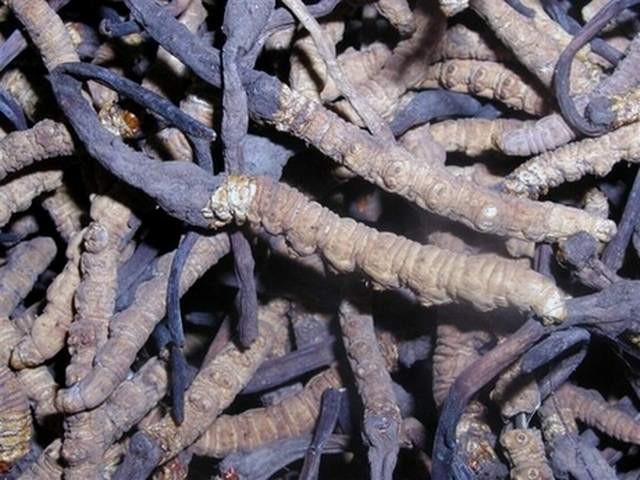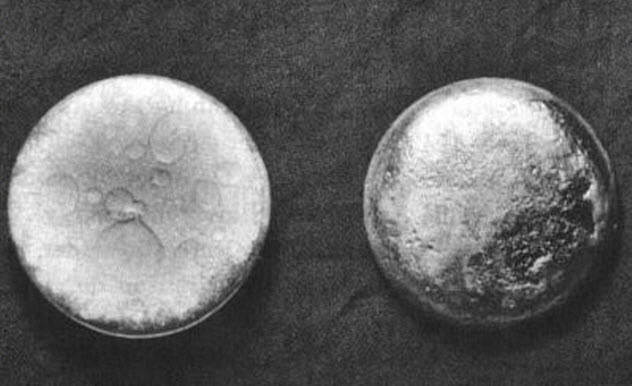 Mysteries
Mysteries  Mysteries
Mysteries  History
History 10 Surprising Stories About the Texas Rangers
 Humans
Humans 10 Philosophers Who Were Driven Mad by Their Own Theories
 Miscellaneous
Miscellaneous 10 Video-Game-Worthy Weapons and Armors from History
 Weird Stuff
Weird Stuff 10 Psychics Who Accurately Predicted Wartime Events
 The Arts
The Arts 10 Pieces of Art Inspired by a Broken Heart
 Health
Health 10 Science Fiction-Sounding New Medical Treatments
 History
History 10 Surprising Facts About the Father of Submarine Warfare
 Space
Space Ten Astonishing New Insights into Alien Worlds
 Weird Stuff
Weird Stuff 10 Bizarre Summer Solstice Rituals Still Practiced Today
 Mysteries
Mysteries Top 10 Haunting Facts About the Ghost Ship MV Alta
 History
History 10 Surprising Stories About the Texas Rangers
 Humans
Humans 10 Philosophers Who Were Driven Mad by Their Own Theories
Who's Behind Listverse?

Jamie Frater
Head Editor
Jamie founded Listverse due to an insatiable desire to share fascinating, obscure, and bizarre facts. He has been a guest speaker on numerous national radio and television stations and is a five time published author.
More About Us Miscellaneous
Miscellaneous 10 Video-Game-Worthy Weapons and Armors from History
 Weird Stuff
Weird Stuff 10 Psychics Who Accurately Predicted Wartime Events
 The Arts
The Arts 10 Pieces of Art Inspired by a Broken Heart
 Health
Health 10 Science Fiction-Sounding New Medical Treatments
 History
History 10 Surprising Facts About the Father of Submarine Warfare
 Space
Space Ten Astonishing New Insights into Alien Worlds
 Weird Stuff
Weird Stuff 10 Bizarre Summer Solstice Rituals Still Practiced Today
Top 10 Things Inherently More Valuable Than Gold
Throughout most of human history, gold has been one of the most prized substances. People tried to transmute lead into it, it’s been the basis of national economies, and it looks great in jewelry.
Despite its rarity and intrinsic value, gold is hardly the most valuable substance available to us. These ten things will cost you far more than a gram of gold (around $57 in August 2021), and they are inherently more valuable.
10 Caterpillar Fungus

Caterpillar fungus is one of the most aptly-named things on this planet, and all you have to do is look at it to understand why. It’s a fungus that grows from the soil with a wormlike protrusion. Dig that up, and you’ll find a part that looks exactly like a caterpillar. It’s got an even better name in Tibet, where it’s known as yartsa gunbu, or “summer grass, winter worm.”
The reason the fungus looks like a caterpillar is because it actually is a caterpillar. “This caterpillar will bury itself down a couple inches into the soil. Meanwhile, it doesn’t know it, but this fungus is digesting it from within, and then in the spring this … tissue erupts out the head.”
The remaining caterpillar bit is the valuable part, and you can probably guess why. Caterpillar fungus is known as the Viagra of the Himalayas. A 15th century Tibetan medicinal text referred to as “An Ocean of Aphrodisiacal Qualities.”
You may think that a black truffle is the most valuable fungus, but it doesn’t compare to the caterpillar fungus. Black truffles can go for around $1.76 per gram, while the far rarer caterpillar fungus reaches about $110 per gram. That makes it nearly twice as valuable as gold.
9 Iridium
Iridium is one of the rarest elements found in the Earth’s crust. Instead, it is primarily found in meteorites. The extinction of the dinosaurs via a massive impact 65 million years ago was identified via a layer of iridium found in the layers of the Earth.
The metal was first discovered in 1803, and it is silvery-white, though incredibly hard and brittle. It’s the second-densest metal known to exist, and it’s rare (on this planet). Still, it does exist, and it has numerous uses in various industries.
Iridium is prized for its corrosion resistance, making it ideal as a hardening agent for alloys containing platinum. It has other commercial uses that saw its value increase exponentially in the early 2000s. That’s when flat-screen LED televisions were becoming popular, and iridium is a principal component.
Iridium is expensive due to its rarity. Since we can’t mine asteroids (yet), finding it is labor-intensive and costly. Iridium trades for around $6,100 per ounce or around $215 per gram. That makes this scarce metal about 3.75 times more valuable than gold.
8 Rhodium
Depending on market fluctuations, rhodium is often the most expensive metal in the world. It’s a silvery-white metal found in the platinum group of noble metals, and it’s naturally corrosion-resistant and chemically inert. You’ve probably got a little rhodium and didn’t know it, as it’s used as a catalyst in a car’s three-way catalytic converter.
That accounts for about 80% of its use globally, but there’s another use that might come your way. Rhodium’s anti-corrosion properties make it ideal for coating substances like white gold and sterling silver, so there’s a good chance you’ve come in contact with rhodium at one time or another.
Still, the automobile industry is the primary consumer of rhodium, and the need for this rare metal often drives its price up. Before the COVID-19 pandemic, rhodium went for around $950 per gram, but it has since cooled a little bit. By mid-August 2021, a single gram of rhodium will set you back around $550.
Another reason for Rhodium’s value is its rarity, as it’s the rarest of the platinum group metals. It can be found in only one part per 200 million in the Earth’s crust. By comparison, gold can be found in around 0.5-5 parts per million, depending on the mining methods used in its extraction.
7 Snake Venom

Most people probably think of snake venom as a bad thing, as it can cause severe injury and/or death. That’s what happens if a deadly snake injects its precious venom into an unsuspecting person. Still, there’s more than one use for snake venom.
Snake venom is needed to make antivenom, and it has other medicinal uses. It can be used as a powerful pain reliever, it can break up blood clots, and reduce blood pressure, so it’s not exactly taken for granted. Harvesting it isn’t exactly easy (snakes have to be “milked”), so it’s an expensive process.
Some snake venom is more valuable than others, and you can probably guess why. The most expensive snake venoms come from the deadliest snakes. The King Cobra’s venom contains a powerful pain reliever, and its venom costs around $153,000 per gallon, or $3,785 per gram.
The Coral Snake, which is the snake with the second-strongest venom (next to the Black Mamba), has venom that costs $4,000 per gram. That makes it just shy of 11 times as valuable as the shiny stuff.
6 Da Hong Pao Tea
You probably didn’t expect to find something like tea on a list, but you’ve probably never heard of Da Hong Pao tea. The Chinese tea is made from the leaves of the Da Hong Pao tree, and the process is stringent in adherence to tradition. It’s also strictly monitored by the Chinese government.
There are only six remaining mother Da Hong Pai trees remaining in the world. They grow on a cliff of the Wuyi Mountain, and they are considered a national treasure. Harvesting and processing the leaves requires seven steps: picking, withering, cooling, making, stir-fry, kneading, and baking.
Da Hong Pao tea is green/brown in color and smells of orchids. It’s said to have a long-lasting aftertaste. Unlike most teas, Da Hong Pai tea can be steeped nine times. It has been used to treat several illnesses, as it contains various compounds that aid in blood circulation.
Because the trees are so rare — there are only six, after all — the price per gram of tea is $1,400, with a pot going for around $10,000. In 2002, 20 grams of Da Hong Pao sold for $28,000. When Nixon opened up relations with China, he was given 200 grams of the stuff. A single gram of this tea costs nearly 25 times what you’d have to pay for a gram of gold.
5 Plutonium

Unless you have a spare DeLorean sitting around with a flux capacitor, odds are, you’ll never come in contact with plutonium. That’s a good thing, seeing as this rare metal is incredibly radioactive. It can accumulate in a person’s bones and is dangerous to handle. Of course, that doesn’t make it worthless, as it’s very valuable.
Because plutonium-239 and 241 are fissile, they can be used to sustain a nuclear chain reaction. This makes plutonium a core element in nuclear weapons and nuclear reactors. It can be synthesized and often is, as its rarity makes collecting it difficult.
It was first discovered in 1938, but it wasn’t until 1940 that it was synthesized via the Manhattan Project. While it can be (and often is) synthesized, it does occur naturally. It can be found in trace elements of natural uranium-238, but this is rare, as it only occurs when the uranium is exposed to the neutrons emitted by other decaying uranium-238 atoms.
Regardless of how it is obtained, its value is incredibly high. If you’re working in an industry that requires plutonium (and that’s the only reason anyone would want this stuff), you’ll have to spend about $4,000 per gram. That makes it around 70 times more expensive than a gram of gold.
4 Red Diamonds
Gram for gram, diamonds are more valuable than gold. Still, when you think of one of these precious gems, you likely picture the clear variety. Those are considered common in the world of diamonds, with different colored diamonds standing as the truly valuable options.
Red diamonds are scarce, but not just in terms of diamonds; they are the rarest gemstones on the planet. Only about 30 of them are known to exist/have been found, and the majority of them weigh less than half a carat (around 0.1 gram).
Depending on the market conditions, red diamonds have been known to fetch as much as $1 million per carat ($5 million per gram). The largest of these gems sold in 2011 for $8 million, and it was only 5.11 carats in size, making it slightly heavier than a gram of gold.
In contrast to everyone’s favorite shiny metal, red diamonds are 87,719 times more valuable than gold. Granted, this would change if someone dug up thousands of the little gems, but that’s unlikely to happen, as they are ridiculously rare.
3 Californium
Californium is a synthetic element first discovered in 1950. It was named after California because it was created at the University of California Radiation Laboratory. The element has numerous practical applications, and while it is synthesized, the process produces very little, making it relatively costly.
Californium is the most expensive chemical used as a valuable trading commodity. It does occur naturally, but because the most common isotope has a half-life of 2.6 years, it’s not found in any sizable quantity in the Earth’s crust. When it was first produced, only about 5,000 atoms were created with a half-life of 44 minutes.
It’s primarily produced by two labs, the Scientific Center of Atomic Reactors in Russia and the Oak Ridge Atomic Reactors in the U.S. Californium has a variety of uses in various industries. Some isotopes emit neutrons, and this is often used to start up nuclear reactors. It can also be used in certain treatments of brain and cervical cancer.
Because it’s challenging to produce in large quantities, a single gram of Californium sells for around $27 million. The prices do fluctuate, but that’s the average. Californium’s value on the commodities market makes it around 473,684 times more valuable than gold.
2 Francium
Francium was the last element on the Periodic Table that was first discovered in nature. Still, it can be synthesized, which is good because this stuff is so rare it almost doesn’t exist. It has been estimated that there are only ever around 20 to 30 grams of francium in the Earth’s crust at any given time.
It occurs in trace amounts in thorium and uranium, but it has a half-life of only 22 minutes, so it’s constantly decaying. It’s also radioactive and difficult to create through synthesis. The largest sample ever produced or isolated consisted of 300,000 atoms. That may seem like a lot, but it’s still too small to observe.
Because francium is so rare, and because it decays so rapidly, it has no commercial uses. Its only current use is scientific research, though it may prove useful in diagnostic testing for certain types of cancer. Despite its lack of commercial use, its rarity makes it valuable.
The price for a single gram of francium is around $1 billion. That’s a billion dollars for something that vanishes from existence in less than an hour. Still, it has uses in research, so it has value. A single gram of francium will cost 17,543,859 times more than a gram of gold.
1 Antimatter
Antimatter is the stuff of science fiction for most people, but it is real and has been known to exist since the early 20th century. Antimatter is any matter composed of antiparticles of any corresponding particles of ordinary matter. It can be created with particle accelerators, but the problem with antimatter is that whenever it comes into contact with matter, both are annihilated.
It cannot be stored in a normal container, so it must be kept in electric and magnetic fields. There are various methods, but it isn’t easy. The longest anyone was able to store it was 405 days, though efforts are being made to improve on this.
Producing antimatter via a particle accelerator is expensive, and the amount produced is infinitesimally small. It has numerous practical and theoretical applications, including medical imaging and spacecraft propulsion.
Antimatter isn’t exactly a tradable commodity, but NASA has given it a value. In 1999, NASA estimated that a single gram of antihydrogen cost around $62.5 trillion per gram. That’s a ridiculously high number that makes it the most expensive thing known to exist. Compared to gold, antimatter is 1,096,491,228,070 times more valuable.








